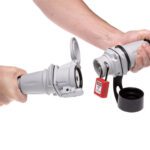Do You Know Basic Connector Attributes?
Guidelines for Connector Specification During Product Design
 Connectors, unfortunately, may contribute to an unacceptably high product failure rate. One reason for this is that connectors are typically a low priority in the initial design phase of the system. This can lead to a design engineer getting boxed in with limited connector space and access if proper connector design was not considered earlier in the design process. Connectors are becoming more system-critical, particularly with the demand for higher speeds, faster rise times, and higher densities. After a connector is selected and designed into the system, it is often very difficult to change because of space restrictions and limited access.
Connectors, unfortunately, may contribute to an unacceptably high product failure rate. One reason for this is that connectors are typically a low priority in the initial design phase of the system. This can lead to a design engineer getting boxed in with limited connector space and access if proper connector design was not considered earlier in the design process. Connectors are becoming more system-critical, particularly with the demand for higher speeds, faster rise times, and higher densities. After a connector is selected and designed into the system, it is often very difficult to change because of space restrictions and limited access.
The Perfect Connector
If you could purchase the perfect connector, what features would it exhibit? Several that immediately come to mind include:
- Zero electrical resistance
- Unlimited dielectric breakdown
- Zero signal distortion
- Zero insertion force
- Unlimited retention force
- Zero extraction force
- Zero size
- Zero piece cost
- Zero application cost
- Meets all required attributes for the application
Well, this is not a perfect world, and there are no perfect connectors.
All real connectors are a compromise from the ideal product and there are thousands of options from which to choose. The goal is to choose the best connector for the given application. So how do you get started? Initially, the responsible engineer needs to identify and document the design specifications for the product. A specification can be defined as a description of the physical and functional characteristics of the connector, as well as the desired cost. Ideally, the requirements should be expressed numerically in terms of their appropriate units and limits where appropriate. Essentially, a specification is a statement of the attributes of the connector the user wishes to purchase.
Specifications have two basic functions: One is to communicate to the potential supplier what is required. The other is to provide criteria against which the connectors can be compared among various manufacturers.
The requirements for these specifications can come from several sources, including but not restricted to the following: sales, marketing, standards, safety approval agencies, and system functionality needs.
Sales and marketing departments typically provide input regarding the connector aesthetics, including texture, color, size, etc., based on customer preferences. These attributes mostly pertain to product visible to the user at levels five and above. Sales and marketing teams should also provide the start-up and production volume forecasts for several years in the future, which would dictate whether a new, custom-made product could be financially justified or if it must be an off-of-the-shelf connector.
Product standards requirements usually also pertain to level five and above and are in place to ensure interchangeability of various connector suppliers’ products. Three of the many standard interfaces are USB, RS-232, and RJ-45. These documents need to be reviewed to ensure compliance.
Safety approval agencies dictate connector requirements, such as spacing between live and dead metal parts of different polarities; flammability requirements; contact retention to housings; insulation resistance between contacts; etc. A few such agencies are Underwriters Laboratories (UL), Canadian Standards Association (CSA), and the European Standards, VDE.
Referring back to the initial Connector Basics article, there are identifiable Levels of Interconnection (LOI) and each of these levels may have specific unique needs. Levels zero through four are internal to the equipment and are usually mated and unmated by skilled manufacturing personnel who are familiar with connectors and are more adept at handling smaller and sometimes fragile connectors. Experience has shown that internal connectors continue to shrink with more closely spaced centerlines. At level five and above, these interconnections are often handled by users that are less familiar with connectors, so robustness is a necessary feature. These products require excellent polarization, retention, lead-in, and strain-relief features.
Once the design specifications are established, someone needs to procure quotes for the specific connectors and fully understand the design goals and limitations so that the best, most reliable choice is made. Assuming that it is true that connectors often contribute to the highest system failure rate, the individual should be extremely knowledgeable about connector types and the various connector suppliers. The person should be an industry expert.
APEX believes that an individual serving as a component engineer needs to be involved in the specification and selection process. In the past decades, the component engineer was more prevalent in industry, primarily with larger companies. It seems that this function has been lost and delegated more to generalists who wear many hats rather than the specialist required for this activity.
A component engineer oversees the selection process of connectors, fully understands the design specifications, and ensures that the product meets or exceeds the requirements. This individual is cognizant of the suppliers in the industry and understands the strengths and weaknesses of each manufacturer. The engineer will not approve the connector for use in the system until all specification requirements are met, or exceeded, and the person is fully responsible for the product’s performance and reliability.
In summary, connectors are often solely responsible for system failures and all connector choices are compromises that deviate from that of the perfect product. Component engineer involvement in the connector selection activity should begin early in the design process. A specialist, knowledgeable in the connector industry, should be responsible for the selection of the interconnection product that will meet the requirements of the product application.
Bill Garver has 47 years experience in the connector industry, primarily in the management and direction of new product development and operational division management. He held the titles of division manager and director of development engineering at AMP. He developed new products throughout the full product life cycle, concept through introduction, for numerous industries, including consumer, commercial, computer, industrial, communications, and medical. Bill has vast experience with products for high-density, low-cost, insulation displacement, surface-mount, high-temperature, and environmentally sealed applications. Please contact him with questions or feedback on this article.








